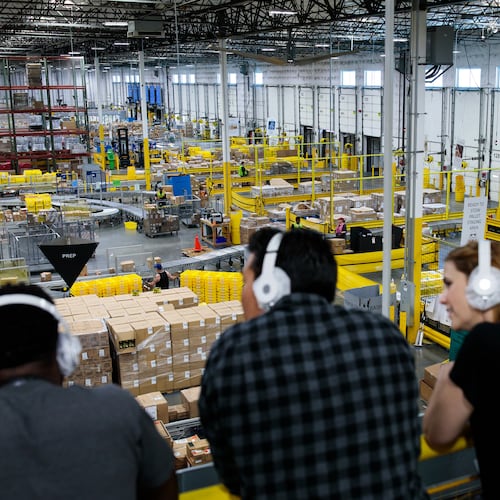In one of the roughest job markets in memory, fast-food positions are proving attractive for job seekers of all ages. Once a workplace ceded largely to teens and part-time workers, fast food is attracting older people with experience, education and marketable skills.
K’wan Banks, 35, went through three rounds of interviews to land a job at a McDonald’s on Riverdale Road. The Everest College graduate has a commercial driver’s license and working experience with Avis Rent A Car. Getting on with McDonald’s, where she is now in training to be a manager, was tougher than she expected.
“Oh my God, yes,” she said. “I didn’t think McDonald’s was that serious.”
Banks said she only recently started thinking of McDonald’s as a potential career. She hopes to become a store manager in the next few months after working in every corner of the restaurant, from cash register to clean-up duty. “You’ve got to learn everything,” she said.
For younger applicants, fast food has been the traditional first job or summer job. Landing that job has become much harder.
Wade Phenicie of Norcross is just beginning his working career and has had a tough job search. He pursued jobs at Papa John’s while on spring break during his freshmen year at Williams College in Massachusetts. For two months, he waited for a callback. On Thursday, he finally got an interview scheduled for a job as a delivery driver.
“I don’t want to get my hopes up,” said Phenicie, 19.
Restaurant owners can afford to be picky as the competition for every opening gets tougher.
Keith Lollis, who operates three McDonald’s restaurants around Atlanta, said his establishments were begging for workers not long ago. Job applicants used to arrive dressed in jeans; he now sees more men in suits and ties or khaki pants and oxford shirts. Women come in dresses. Perhaps one in 10 applicants has a college education, up from one in 30 or 40 less than a year ago.
“The quality of applicant has gotten better,” Lollis said. “They are coming dressed better and presenting themselves better. They look sharp, they act sharp and they keep eye contact.”
The restaurant industry is the country’s second-largest private employer behind health care. Of the industry’s workforce, 42 percent is 24 or younger, and upward mobility is a big draw. More than 90 percent of salaried employees started as hourly employees, according to industry statistics.
Before the recession, Aziz Hashim’s restaurants had trouble finding enough workers. A lot of young people weren’t interested in fast-food jobs, preferring to work at the mall or at Gap rather than Popeyes, Checkers, Rally’s or Domino’s Pizza.
They are interested now, said Hashim, chief executive of Decatur-based National Restaurant Development Inc.
“If we open up even a very modest job opening, it would not be unusual for us to get 50 or 100 applications,” said Hashim, who has restaurants in Atlanta, Los Angeles, Phoenix, Jacksonville and Orlando.
In the Chicago suburb of Aurora, Chick-fil-A operator Doug Lockwood said he has collected hundreds of applications, even though he’s not hiring or advertising positions.
The fast-food segment is the fastest growing corner of the overall restaurant industry, which is pulling out of a three-year slump. In the 12-month period ending in March, fast-food employment rose 2 percent, compared to a 1.3 percent increase in jobs at restaurants that offer table service, according to the National Restaurant Association.
The long queue for available jobs is apparently keeping wages from rising. Fast-food workers have seen their pay stay basically flat for a year. The average hourly wage was $8.93 in March, according to preliminary numbers from the Bureau of Labor Statistics. In March last year, the same jobs paid $8.81 per hour for production and nonsupervisory employees. The national minimum wage is $7.25.
Nelquita Clemmons, 26, got a job at an Atlanta McDonald’s three weeks ago. She had studied to become a medical administrative assistant, and hopes to use the new overnight cleaning job as a stepping stone to something better. “I’m always looking for more opportunities, more benefits, more pay,” she said.
Other factors have attracted people to fast-food openings. The industry has had some success getting rid of the stereotype of the dead-end “McJob,” convincing more people to give it a whirl. Some applicants see the jobs as a long-term opportunity, not just a stop-gap measure.
Matthew Robinson, 16, got a job last summer working the register and cleaning tables at a Chick-fil-A restaurant on Howell Mill Road in Atlanta. He just finished sophomore year at Westminster and plans to work at Chick-fil-A through his senior year. He said he’s looking forward to taking on more responsibility, such as working in the kitchen.
In addition to the attractive applicants, restaurants now find their employees tend to hang onto jobs as long as possible, reducing what used to be a constant churn of departures and hiring.
Arthur Greeno, a Chick-fil-A operator in Tulsa, said his store crews are stable. “I’ve got to be honest, the economy helps,” he said. “When the economy is tough, people with jobs aren’t going to be out looking for jobs.”
“There are plenty of people to choose from,” said John Challenger, chief executive of Chicago-based Challenger Gray & Christmas, an outplacement consulting firm. “There are lots of people who want these jobs, need them and would love to have them.”
The Georgia angle
The unemployment rate is 9.7 percent in metro Atlanta. Nationally, it’s 9 percent. The jobless rate is 14.6 percent among people who don’t have a high school diploma; and among teens, unemployment stands at 24.9 percent.
More than 1 million people applied for jobs at McDonald’s when it put out the call for applications last month; the chain hired 62,000. That 6.2-percent acceptance rate was lower than Harvard University’s for its class of 2014.
About the Author
Keep Reading
The Latest
Featured


